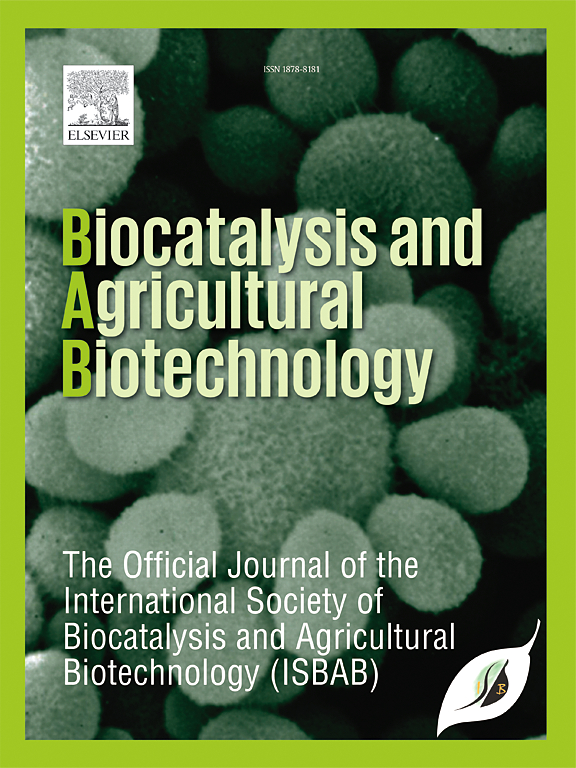蛇果醋独特的保肝抗炎活性用CCl4对Wistar大鼠进行混合培养发酵
IF 3.4
Q2 BIOTECHNOLOGY & APPLIED MICROBIOLOGY
引用次数: 0
摘要
蛇果醋(Salacca zalacca (Gaerth.))的保肝作用尽管人们对果醋的健康益处越来越感兴趣,但沃斯(Voss)先前并未在化学诱导的肝损伤模型中进行过研究。本研究旨在评价经四氯化碳(CCl4)诱导的肝毒性大鼠单培养和混合发酵制备的蛇果醋对肝脏的保护和抗炎作用。将20只雄性大鼠随机分为4组:健康对照组(K−)、ccl4诱导对照组(K+)、单培养醋处理(P1)和混合培养醋处理(P2)。醋按0.75 mL/kg体重口服28天,CCl4在干预的最后8天腹腔注射。与ccl4组相比,混合培养处理(P2)显著降低血清ALT(43.8±5.94 IU/L)、AST(133.6±2.50 IU/L)和MDA(2.18±0.26 mg/L)(分别为76.4±5.13、249.4±8.26和6.49±0.54 mg/L);p & lt;0.05)。组织病理学分析显示P2组肝脏结构改善,损伤评分为1,而未治疗的CCl4组为3。此外,与K+组(2.80±0.32、3.36±0.36和0.21±0.22 pg/mL)相比,蛇果醋组可下调促炎细胞因子TNF-α和IL-6(分别为1.56±0.22和1.74±0.15 pg/mL),上调抗炎细胞因子IL-10(1.22±0.28 pg/mL);p & lt;0.05)。这些发现证实了蛇果醋,特别是混合发酵的蛇果醋,具有显著的保肝和抗炎作用,可能是一种有前景的肝脏健康功能食品。本文章由计算机程序翻译,如有差异,请以英文原文为准。
Distinctive hepatoprotective and anti-inflammation activity of snakefruit vinegar (Salacca zalacca (Gaerth.) Voss) with mixed culture fermentation induced by CCl4 in Wistar rats
The hepatoprotective efficacy of snakefruit vinegar (Salacca zalacca (Gaerth.) Voss) has not been previously investigated in models of chemically induced liver injury, despite growing interest in the health benefits of fruit vinegars. This study aimed to evaluate the hepatoprotective and anti-inflammatory effects of snakefruit vinegar produced via single- and mixed-culture fermentation in carbon tetrachloride (CCl4)-induced hepatotoxicity rats. Twenty male rats were randomly assigned to four groups: healthy control (K−), CCl4-induced control (K+), single-culture vinegar treatment (P1), and mixed-culture vinegar treatment (P2). Vinegar was administered orally at 0.75 mL/kg body weight for 28 days, while CCl4 was injected intraperitoneally during the final 8 days of the intervention. Mixed-culture treatment (P2) significantly reduced serum ALT (43.8 ± 5.94 IU/L), AST (133.6 ± 2.50 IU/L), and MDA (2.18 ± 0.26 mg/L) compared to the CCl4-only group (76.4 ± 5.13, 249.4 ± 8.26 IU/L, and 6.49 ± 0.54 mg/L, respectively; p < 0.05). Histopathological analysis revealed improved hepatic architecture in P2, with a damage score of 1, versus a score of 3 in the untreated CCl4 group. Additionally, treatment with snakefruit vinegar downregulated pro-inflammatory cytokines TNF-α and IL-6 (1.56 ± 0.22 and 1.74 ± 0.15 pg/mL, respectively) and upregulated anti-inflammatory IL-10 (1.22 ± 0.28 pg/mL), in contrast to the K+ group (2.80 ± 0.32, 3.36 ± 0.36, and 0.21 ± 0.22 pg/mL; p < 0.05). These findings confirm that snakefruit vinegar, particularly from mixed-culture fermentation, exerts significant hepatoprotective and anti-inflammatory effects, and may serve as a promising functional food for liver health.
求助全文
通过发布文献求助,成功后即可免费获取论文全文。
去求助
来源期刊

Biocatalysis and agricultural biotechnology
Agricultural and Biological Sciences-Agronomy and Crop Science
CiteScore
7.70
自引率
2.50%
发文量
308
审稿时长
48 days
期刊介绍:
Biocatalysis and Agricultural Biotechnology is the official journal of the International Society of Biocatalysis and Agricultural Biotechnology (ISBAB). The journal publishes high quality articles especially in the science and technology of biocatalysis, bioprocesses, agricultural biotechnology, biomedical biotechnology, and, if appropriate, from other related areas of biotechnology. The journal will publish peer-reviewed basic and applied research papers, authoritative reviews, and feature articles. The scope of the journal encompasses the research, industrial, and commercial aspects of biotechnology, including the areas of: biocatalysis; bioprocesses; food and agriculture; genetic engineering; molecular biology; healthcare and pharmaceuticals; biofuels; genomics; nanotechnology; environment and biodiversity; and bioremediation.
 求助内容:
求助内容: 应助结果提醒方式:
应助结果提醒方式:


